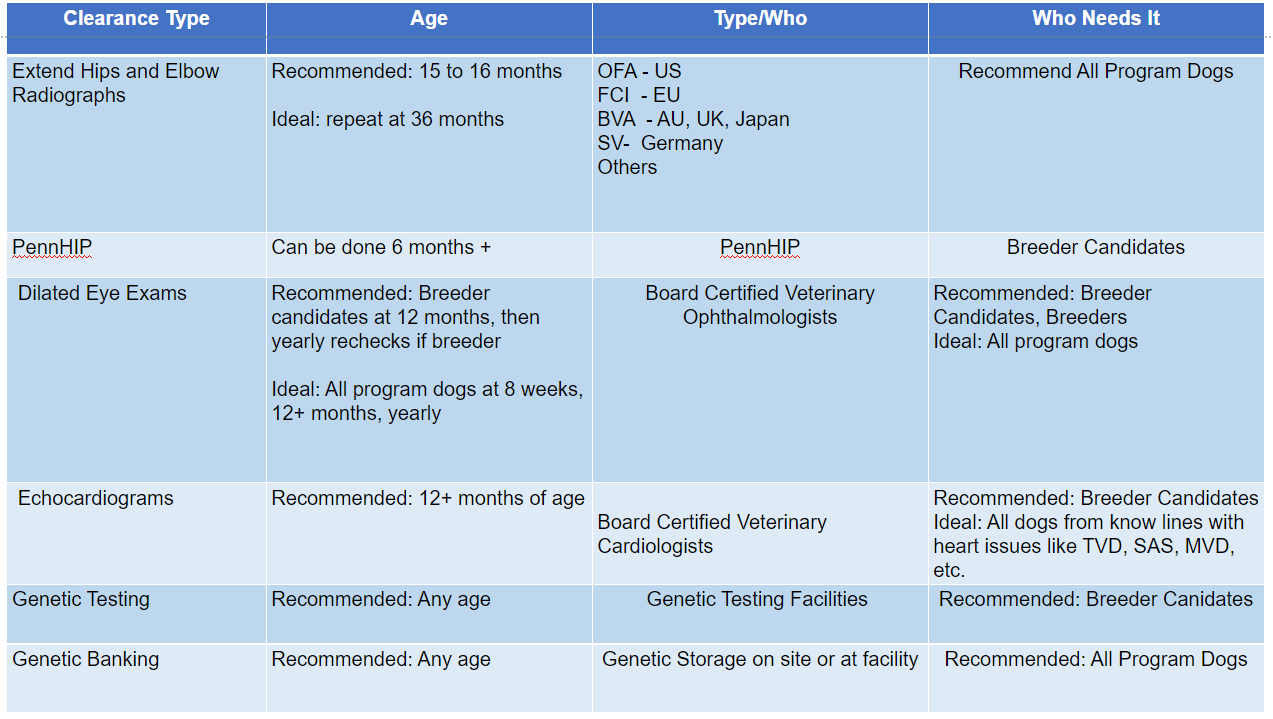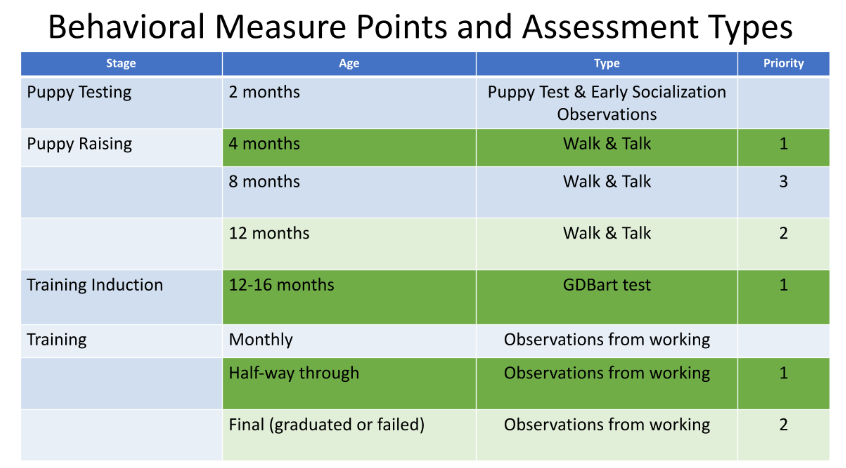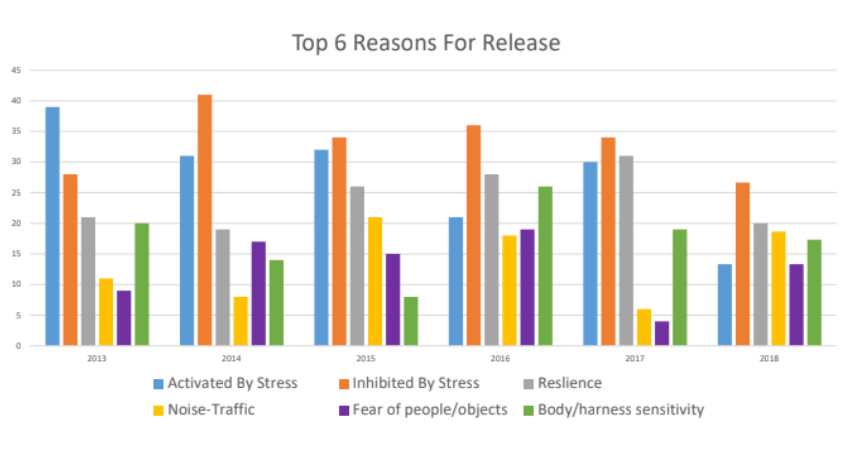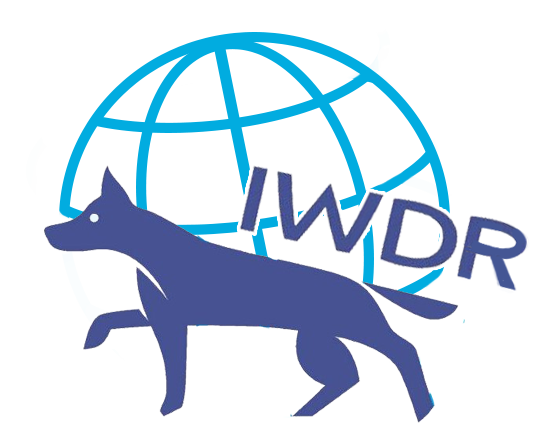-
Behaviour Scoring
-
- 1. Anxious in unfamiliar situations
- 2. Fear Of Noises
- 3. Fear of Novel Objects
- 4. Fear of Underfootings
- 5. Fear of Dogs
- 6. Fear of Stairs
- 7. Fear of Traffic
- 8. Separation Anxiety
- 9. Hyper-Attachment
- 10. Fear Of Strangers
- 11. Body Handling Concern
- 12. Retreats When Reached For
- 13. Harness Handle On Back Sensitivity
- 14. Avoidance Of Blowing Fan
- 15. Body Sensitivity To Object Contact
- 16. Anxious About Riding In Vehicles
- 17. Inhibited or passively avoidant when exposed to potentially stressful situations
- 18. Activated when exposed to potentially stressful situations
- 19. Excitable
- 20. Slow To Return To Productive Emotional State
- 21. Fidgety When Handler Is Idle
- 22. Fear On Elevated Areas, Drop-Offs Etc.
- 23. Barks Persistently
- 24. High Energy Level
- 25. Lacks Focus
- 26. Movement Excites
- 27. Chasing Animals
- 28. Dog Distraction
- 29. Sniffing
- 30. Scavenges
- 31. Inappropriate Behavior Around The Home
- 32. Lacks Initiative
- 33. Not Willing
- 34. Resource Guarding Toward People
- 35. Aggression Toward Strangers
- 36. Aggression Toward Dogs
- 37. Resource Guarding Toward Dogs Or Other Pets
- 38. Inappropriate Elimination While Working En Route
- 39. Socially Inappropriate Behavior With People
- 40. Inconsistent
- 41. Handler/Dog Team
- 42. Relationship Skills
- 43. Comparison 9 To 1 Score
- 44. Socially Inappropriate Behavior With Dogs
- 45. Thunder Reaction Prior To, During Or Immediately After A Thunderstorm
- 46. Kennels Poorly
- 47. Working Speed
- 48. Gait When Moving Out
- 49. Housebreaking Problems
- 50. Innate Desire To Work
- 51. Avoidance Of Exhaust From Vehicles
- Show all articles ( 36 ) Collapse Articles
-
-
-
Practice Videos
-
Behavior Testing
-
Database User Manual
-
-
-
- Adding a New Dog (using Manage Your Dog’s Data, MyDogs)
- Alerts
- BCL, Behavior Checklist
- Elbow Quick, Add new
- Estrus & Whelps
- Eye Quick
- Genetic Test Panel
- Genetic Test Quick
- Health Diagnoses Add/Edit
- Health History Report
- Health Normals, Add new
- Heart Quick
- Hip BVA, Add new
- Hip FCI, Add new
- Hip OFA, Add new
- Hip Penn Hip, Add new
- Photos PDFs etc.
- Private Notes
- Procedures, Add new
- Reminders
- Share my dog data to another organization
- Skin Quick
- Status History
- Weight - Entering a dog's weight
- ADI Public Access Test
- Hip Vezzoni, Add new
- Status Detail
- Edit or Change Call Name / Pedigree Name / Owner ID
- Add New Microchip / Delete Incorrect Microchip
- End Reasons
- Juvenile Estrus
- Communications Activities
- Incidents
- Show all articles ( 18 ) Collapse Articles
-
- Articles coming soon
-
-
-
-
- Alternate Therapy/Rehab
- Diagnostic Imaging, Add new / Edit or Delete
- Diet
- Elbow Quick, Add new / Edit or Delete
- Estrus & Whelps, Add new
- Eye Quick, Add new / Edit or Delete
- Genetic Test Quick, Add new / Edit or Delete
- Health Diagnoses, Add new / Edit (Update) or Delete
- Health History Report, Generate a PDF
- Health Normals
- Health Screening List
- Hip OFA Add new / Edit or Delete
- Hip Penn Hip Add new / Edit or Delete
- Hospitalization, Add new
- Kennel Tasks, Add new / Edit or Delete
- Lab, Add new / Edit or Delete
- Photos, PDFs, etc., Add new
- Reminders Add new / Edit or Delete
- Rx, Add new / Edit or Delete
- Semen Cryo, Add new / Edit or Delete
- Skin Quick Add new / Edit or Delete
- SOAP, Add new / Edit or Delete
- Status History
- Supplies Used, Add new / Edit or Delete
- Surgery, Add new
- Treatments Add new / Edit or Delete
- Vaccines Add new / Edit or Delete
- Weight and BCS Body Condition Score - Add new / Edit or Delete
- Hip Vezzoni, Add new
- Show all articles ( 14 ) Collapse Articles
-
-
-
-
Early Socialization
-
- Video - Coat Desensitization
- Video - Novel Objects
- Video - Trolley Ride with Mom
- Early Puppy Socialization - Novel Objects video
- Early Puppy Socialization – Novel Sounds video
- Early Puppy Socialization – Introducing New Environments video
- Early Puppy Socialization – Motor Development, Balance, Coordination, Proprioception video
- Early Puppy Socialization – Passive Environmental Enrichment in the Den video
- Early Puppy Socialization – Stairs
-
-
Genetic Selection & Inbreeding
-
- What are EBVs and how do they help?
- How EBVs are calculated
- What is needed to calculate EBVs and EBV accuracy?
- Using EBVs effectively
- Selection index
- Why are EBVs different for littermates?
- Presentation Recording: Improving behavior using EBVs
- Presentation Recording: Using EBVs successfully
- Presentation Recording - Improving health using EBVs
-
Webinars
-
Reproduction
-
Organization Management
What data should I collect?
Introduction
When it comes to data collection and what is needed to make significant improvements in a colony, the message is simple: keep everything and turn raw data into something usable. This message can be overwhelming, but at its core there are simple, efficient steps to take to achieve useful, structured, accurate data. The first being electronically storing all data for ease of access and use.
The International Working Dog Registry (IWDR) Database provides serious breeders with the opportunity to use estimated breeding values and other tools to help reliably produce healthy dogs with useful temperaments and sound structure, while also maintaining genetic diversity. Although breeding lays the foundation, socialization, physical conditioning, building a positive relationship, welfare, and training, all work together to transform a young puppy into an adult working dog that people find essential for completing many tasks. Young puppies born without an adequate genetic foundation can be difficult to mold and train into a successful working dog – in contrast, a strong genetic foundation coupled with proper early socialization, appropriate exposure to the real world, and a strong training program will often result in highly valued working dogs that do their job with confidence and ease. Good data collection practices can help streamline and improve any breeding program. Find out more about the IWDR for data keeping here: https://www.iwdr.org/#about
The second is making sure data coming into the program is accurate and consistently measured. This can be achieved by setting up scheduled exams, assessments, talking to veterinarian partners about communicating clear diagnoses (i.e. ear debris vs ear flush vs otitis), and sending out health surveys to keep a lifetime record of a dogs’ health and behavioral data. The data, itself, can be split into general categories: health/clearances, behavioral, and reproductive.
Health
Health data refers to a dog’s lifetime of medical records. Some of the records are gathered at specific points during the dogs’ life and others are ongoing and ever changing. The minimum recommendation for tracking a dog’s health history is from when it entered a program to when it leaves, making sure to enter the data from every veterinary visit and/or health check. This includes entering normal findings as well as the abnormal/diagnoses. The preferred recommendation is keeping records from birth to death. This can be achieved by sending out surveys or inquiries to the people or organizations currently in charge of the dog’s health.
>> More information on Health Surveys, including information on how to integrate a standardized health survey using API is coming soon.
>> Alternatively, you could use Surveymonkey or a similar program, click here to learn more.
There are some health diagnostics/tests that are recommended at specific points of a dogs’ development. Orthopedic radiographs and screenings, referring to elbows and hips, are recommended for all dogs in the program around the ages of 15 to 16 months and repeated at 36 months.
If a dog is in breeding contention, additional orthopedic screening in the form of PennHIP is recommended. The baseline for dilated eye exams performed by board certified veterinary ophthalmologists is for breeding candidates to be screened at around 12 months of age and repeated yearly if the dog becomes a breeder. Ideally, all program dogs should be screened by board certified veterinary ophthalmologists at 8 weeks, around 12 months, and repeated yearly until retired or at least 8 years old. Around 12 months or older, echocardiograms performed by board certified veterinary cardiologists are recommended for all breeder candidates. Ideally, echocardiograms performed by board certified veterinary cardiologists are done on all dogs or litters from lines with known cardiac issues. When possible, have the same cardiologists perform the echocardiograms each time to develop a relationship and understanding of their criteria. Genetic testing is recommended for all breeding candidates and banking all dogs’ genetic material is preferred.

We have some further guides for specific data entry of various health records. Here are a few for you to get started:
Behavioral
Behavioral data needed can be confusing, subjective, and inconsistent. It is recommended programs adopt a universal language and system when it comes to evaluating and documenting behavior.
IWDR uses the Behavior Checklist or BCL as a standardized scoring method. “Behavior Checklist (BCL) is a behavior scoring system developed by Dr. James Serpell from the University of Pennsylvania, USA in collaboration with multiple guide dog organizations, especially The Seeing Eye and Guiding Eyes for the Blind. The BCL provides a way to describe aspects of behavior important for guide and service dogs. Importantly the BCL has been validated and demonstrates the capacity to measure behavior in a consistent manner that lends itself to analysis.”–IWDR
There are certain times within the dogs’ life that collecting BCL data or behavioral data is most useful: 4 months, when first admitted for training (typically 12-16 months and and 2 points in training (half way through formal training and at the end of training or when released from the program. Additional evaluations are recommended at 8 months, 12 months, and at breeder evaluation.

This data can be collected via a formal assessment like a puppy testing or GDBART Test, or by less formal sessions like a walk and talk, where a staff member/instructor walks with and observes the dog & handler to assess the dog’s behavior in various day-to-day situations.
Additional behavioral data like a dog’s status throughout its program experience, age and reasons for releases, and final placement like guide dog, mobility support, hearing, facility therapy, etc. are also recommended to record.

A quick note on puppy testing and why this isn’t a formal recommendation for career releases. Puppy tests vary considerably in their value due to variations within and between organizations based on the level of early socialization. Additionally, puppies’ experiences often vary due to illness, volume of puppies passing through the system at specific times, and/or testing methods used and age when done. The puppy is still only half-way through the critical socialization period and given adequate socialization opportunities pups will continue to express their optimized genetic potential. Puppy testing is best utilized to help set the puppy’s raiser up for success – testing allows us to recognise traits about individual puppies and form a plan to support the puppy and its raiser during the next stage of development. It also can be used as a review for policies and early socialization, for example, if all litters are fearful of vacuums this could indicate a lapse in socialization protocol or a need to change the way you are exposing your puppies to the stimuli.
Reproductive
Reproductive health data is important for all dogs, not just breeder candidates and breeders. At the most basic, keeping track of heat cycles, including cytology and bloodwork, vaginal health like inverted vulva, vaginitis, and urinary tract infections, and testicular health like cryptorchid or cancer on all dogs will help make informed decisions on who should be considered a breeder candidate. Once a candidate or breeder additional information like brucellosis testing and other specialized bloodwork, insemination details, whelp quality, and lactation are all recommended data to track.
Further information
Further information on data entry and best data keeping practices to best manage your breeding dogs and fully utilize the features of IWDR can be found within our 3-part webinar series, linked below.
- IWDR selection index, EBVs, and Interpret EBV Accuracy
- IWDR Data used for EBVs – How and when to take measurements
- Using IWDR Reports: Data trends, impact of missing data, production summaries
This series is currently only available to IWDR subscribers or IWDA members who are logged in. If you have found this information helpful, we hope you will consider supporting us by joining the IWDR or IWDA. We endeavour to keep membership fees affordable and fees directly contribute to the creation of content like this.

